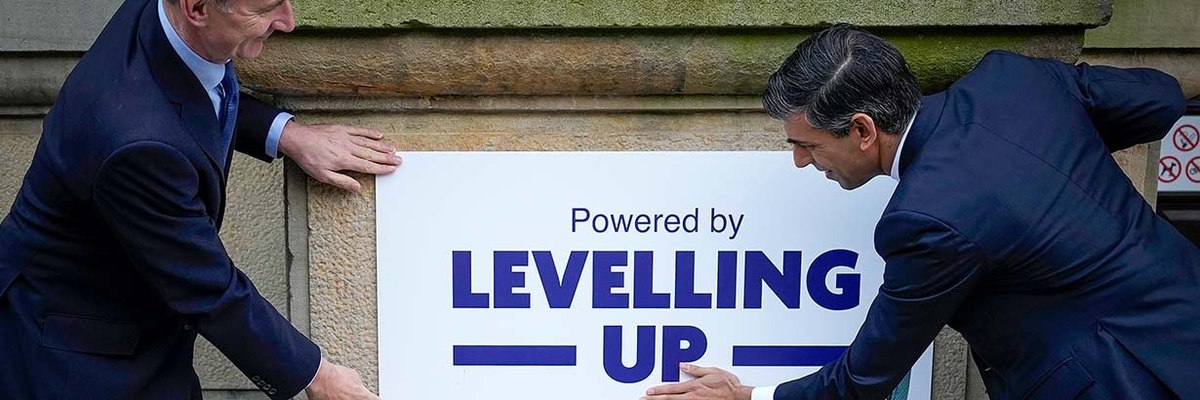Has there been a benefit from the first round of Levelling Up funding to local public pride and optimism? Our latest MRP-driven evidence suggests not
As the government today announces another round of Levelling Up funding, YouGov MRP analysis reveals that many people in the target areas of the first funding round are more likely to think their local area has declined than improved in recent years, and many believe that their community is the kind of place that “people are trying to get away from”.
After collecting over 100,000 survey responses between August and October last year, we then used a statistical technique named Multilevel Regression and Poststratification (MRP) to estimate the proportions of each local authority in England, Scotland, and Wales holding each respective opinion.
Our analysis suggests that there is little optimism or positivity about local areas among the very people the Levelling Up fund was designed to benefit.
In only four local authorities do people tend to think that their local areas have generally improved in recent years. While in 215 local authorities the most common opinion is that the local area has stayed about the same, in as many as 142 council areas people tend to believe the local area has generally declined.
As many as seven in ten of the top priority Levelling Up funding local authorities from Round 1 (64 council areas) are among those where people say the local area has gone downhill. In the other 25 people tend to believe their local area has stayed largely the same; in no top tier target authority do people generally believe their area has improved recently.
While ‘no real change’ may be the prevailing view in most council areas, taking the data a step further and looking at whether those with a different view are more likely to say their area has improved or declined reveals that in almost all places people are more likely to say the latter.
In the 215 local authority areas where the most common view is that the local area has remained much the same over recent years, in fully 208 those who take a different view are more likely to say it has declined than improved. In just seven is the opposite true.
The strongest sense of decline appears in areas like Stoke-on-Trent (49%), Havering (48%), Thurrock (48%) and Rotherham (47%).
There are notable regional differences, with people in local authority areas in Scotland and the South generally less likely to feel their local area has declined.
In London, however, there is a great deal of variation from area to area. The aforementioned Havering has the second highest rate of people sensing decline in the country, yet at the same time the only four local authorities where “generally improved” comes out on top are also in London: Hackney (38% generally improved), Islington (36%), Southwark (36%), and Tower Hamlets (34%).
The mean share of the local population in 2021 top priority Levelling Up areas who believe their locality has declined is 41%, slightly less at 37% in tier two, and slightly less again at 35% in tier three (those areas not earmarked for any round one funding).
Of all local authorities where “generally declined” is the prevailing view, nearly half (64) are in the top level of 2021 Levelling Up funding.
Residents of Barking and Dagenham, Boston, and Newcastle-under-Lyme are most likely to see their local areas as places people want to get away from
A separate question asked Britons whether they live in “the sort of place that people try to get away from” versus “the sort of place that people would like to move to”.
The results show 45 council areas where the local population tend to take the gloomy view.
The London borough of Barking and Dagenham, as well as Midlands towns Boston and Newcastle-under-Lyme stand out, with more than half of people in each area describing them as the kind of place people flee if they get the chance.
The wider grouping of 45 council areas includes several large urban areas like Sunderland, Wigan, Coventry, Bolton, Stoke-on-Trent, Wakefield, Croydon, and Wolverhampton, large towns such as Luton, Stevenage, Oldham, Harlow, and Hyndburn, as well as some more rural areas such as North Lincolnshire, Ashfield, Pendle, and Boston.
There are notable regional divides in whether people view their area as the type of place people are trying to get away from or move to. Opinions across London, the South, and Scotland are generally more positive about their local area than they are on average in the North.
With many top priority areas from the first round missing out on the funding announced today, it remains unclear if the government’s strategy to Level Up areas in the North and Midlands is having, or will have, any discernible effect on local public opinion about opportunities and improvements in their communities.
Data tables can be downloaded here
YouGov interviewed over 115,000 British adults between 9th August and 21st September 2022, and used Multilevel Regression and Post-Stratification (MRP) to model the estimated outcomes at the local authority level (district, metropolitan borough, London borough, and unitary authority). MRP models first estimate the relationship between a wide variety of characteristics about people and their opinions – in this case, beliefs about their local areas – in what is called a ‘multilevel model’, which allows us to account for specific area (in this case, council) level effects as well as background information about respondents themselves. MRP then uses data at the local authority level to predict the outcomes at council level based on the concentration of various different types of people who live there. The model assigns each type of person a probability of (1) believing their area has “generally improved” or “generally declined”, and then (2) believing their area is the type of place people are trying to “get away from” versus “move to” (this is the ‘post-stratification’ component), and then estimates the area-level distributions using information about how many of those specific types of voters live in each area. In this instance, 1000 draws from the posterior distribution of the multilevel model were used to predict the council-level probabilities, which ran for 10,000 iterations across four parallel chains. MRP has been successfully used to predict the outcomes of both the 2017 and 2019 UK General Elections.
Photo: Getty











